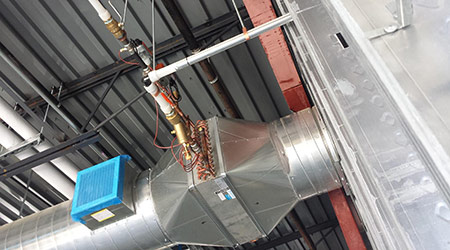More than 17 billion feet of PEX, or crosslinked polyethylene, has been installed worldwide. That’s enough to stretch to the moon and back almost seven times. In recent years, it has increasingly been installed in commercial and residential hydronic applications, despite copper and steel’s traditional dominance in that heating segment.
Although thoroughly tested and proven, PEX is still sometimes misunderstood by mechanical contractors and engineers. Many wonder if a plastic pipe can really compete with, let alone outperform, metallic pipe in virtually every way.
The following article, in a question-and-answer format, attempts to address common questions a commercial installer or a specifying engineer who is new to PEX typically has about the material. In doing so, it explains why PEX is the right choice for hydronic distribution piping applications.
Is all PEX the same?
No. Professional PEX products fall into three categories: PEX-a, PEX-b and PEX-c. Of those three, PEX-a, manufactured using the Engel Method, has the highest degree of consistent crosslinking — at 80 percent. This produces a pipe that is more flexible and more durable with thermal and elastic memory properties.
How can PEX-a help improve health and safety on the jobsite?
There are multiple ways PEX-a offers improved health and safety for installers when compared to metallic piping systems:
-
PEX-a is significantly lighter than metallic piping. In fact, a stick of copper is three times heavier than a stick of PEX-a of the same length; carbon steel is even heavier. This makes PEX-a easier and safer to move around the jobsite, since there is less stress on installers’ bodies.
-
Installing PEX-a requires less “hot work” — welding/sweating/fusing — than metallic or other polymer pipes. Roughly 4,400 structure fires break out each year from equipment associated with hot work, resulting in an average of 12 deaths and $287 million in property damage. The ASTM F1960 fitting connection of PEX-a minimizes the amount of hot work needed in a system and, therefore, greatly reduces the safety risks involved.
-
The PEX-a connection also eliminates glues, solvents and/or other potentially hazardous materials that might be necessary with other connections. Also, because PEX-a does not pit, scale or corrode, fewer nitrites, azoles and other chemicals must be used inside the piping to maintain a static hydronic environment.
How does choosing PEX-a impact the installer’s bottom line?
PEX-a is not an open-market commodity like copper, so its pricing is far more stable over time. Meanwhile, its inherent physical properties deliver significant savings on the jobsite.
-
PEX-a can be run in continuous coils, up to 1,000 feet in length, resulting in fewer required fittings.
-
Its thermal memory (see next question) allows fast and easy kink repairs with a simple shot of heat from a heat gun, minimizing the time and cost of pipeline repairs.
-
PEX-a designs can be prefabricated, saving time and money on the front end.
-
With pipe support, PEX-a can be spaced similarly to copper, meaning no extra costs for hangars.
-
As noted above, fewer chemicals need to be added to a PEX-based hydronic system to prevent pitting, scaling and corroding.
-
The product’s light weight lessens the need for heavy machinery, such as forklifts and cranes, to move it.
-
Again, as noted above, making PEX connections involves no hot work. That eliminates the need — and the expense — for fire-watch measures.
What is thermal and elastic memory?
Thermal memory is the ability to repair accidental kinks in the PEX-a piping with a controlled heating source, such as a heat gun. The controlled heat quickly eliminates the kink in minutes, while the pipe is restored to its original durability.
Elastic memory refers specifically to how PEX-a piping will quickly return to its original dimensions after expansion. This allows the use of the exceptionally strong, ASTM F1960 fitting connection.
In creating a PEX-a connection, the installer uses a specially made expansion tool to enlarge the diameter of the pipe, so that a fitting with a slightly larger internal diameter can be inserted. The pipe quickly compresses over the fitting, creating a durable connection that actually strengthens over time.
Just as important: Because the fitting diameter is a bit larger than the pipe diameter, “dry-fit” pipe connections are physically impossible. This eliminates the problem when an installer neglects to solder or glue a fitting in a copper or CPVC system, resulting in costly leaks inside the walls of a completed project. An ASTM F1960 fitting requires the connection be fully made, permitting quick visual confirmation: If you can see the fitting is inside the pipe, the connection is done.
How strong is the PEX-a fitting connection?
Unlike with metallic pipe, the fitting is actually the strongest part of a PEX-a system. It will not leak. In fact, pull testing shows that even 3,000 pounds of force with over 13 inches of displacement does not compromise the integrity of the ASTM F1960 PEX-a connection. In all likelihood, there would be a catastrophic failure of the building structure before enough force is applied to break that connection.
Does PEX-a require more hangers and supports than metallic systems?
PEX-a pipe can be hung at similar intervals as metallic pipe. It’s true that other plastic piping systems typically require supports every 32 inches. Some manufacturers, however, offer PEX-a pipe supports — a galvanized steel channel that provides continuous support in suspended-piping applications. This support allows PEX-a to behave just like a metallic piping system in many ways, including hanger spacing: ½-inch and ¾-inch PEX-a pipe can be hung at 6-foot intervals; 1-inch through 3-inch pipe, at 8-foot intervals. This translates to significant savings on hangers and supports, especially in commercial environments.
How are expansion and contraction addressed when it comes to PEX-a?
The PEX-a pipe support controls the natural expansion and contraction that occurs as the piping heats and cools. Used in conjunction with manufacturer-recommended installation practices, the pipe support allows PEX-a to undergo an expansion rate equal to or, in some cases, less than that of copper.
Can PEX-a look aesthetically appealing when installed?
When PEX-a pipe support is applied to PEX-a in a hydronic system, it creates the long, evenly spaced, rigid runs that contractors and building owners expect. It will look just as professional as a metallic system.
How does PEX-a correlate to hydronic systems with respect to temperature and pressure?
PEX-a is rated for continuous operation at 200°F at 80 psi (pounds per square inch). Any hydronic application with water temperatures at or below this value is perfectly applicable for the product.
Is PEX-a rated for fire-resistant construction practices inside a non-ducted, return-air plenum?
PEX-a is ASTM E84-rated for flame- and smoke-resistance inside a non-ducted, return-air plenum. This also applies to fire stopping. For more information regarding these listings, please contact the manufacturer.
Is PEX-a UV-rated?
Yes, for Uponor, colored PEX-a pipe has a 90-day rating for direct sunlight exposure; white pipe, a 30-day rating. In addition, the PEX-a packaging and installation guidelines minimize the amount of exposure. Of course, common sense should be used not to leave the pipe exposed to sunlight beyond the duration of the rating.
Can PEX-a be used for re-pipe applications?
PEX-a suits re-pipe applications for all the reasons discussed above. Its lightweight, flexible properties make it easy to maneuver around and through even the tightest spaces and chases on a jobsite. This is especially valuable in the restoration of a historical property where walls and/or ceilings may not be relocated. In addition, the absence of hot work minimizes the threat of fire, while its ASTM F1960 fitting connections allow for strong connections.
Is PEX-a compliant with all codes and standards?
Yes, PEX-a is compliant with all codes and standards that pertain to it, be they in the International family (IBC, IRC, IMC, IPC) or the Uniform family (UMC, UPC, CPC) of U.S. Codes.
Aaron Stotko is a Commercial Segment Manager at Uponor. He can be reached at aaron.stotko@uponor.com.

 Designing Healthcare Facilities for Pediatric and Geriatric Populations
Designing Healthcare Facilities for Pediatric and Geriatric Populations Kaiser Permanente Announces New Hospital Tower at Sunnyside Medical Center
Kaiser Permanente Announces New Hospital Tower at Sunnyside Medical Center Building Disaster Resilience Through Collaboration
Building Disaster Resilience Through Collaboration Amae Health Expands to New York City
Amae Health Expands to New York City Hospital for Special Surgery Opens Two New Facilities in New Jersey
Hospital for Special Surgery Opens Two New Facilities in New Jersey